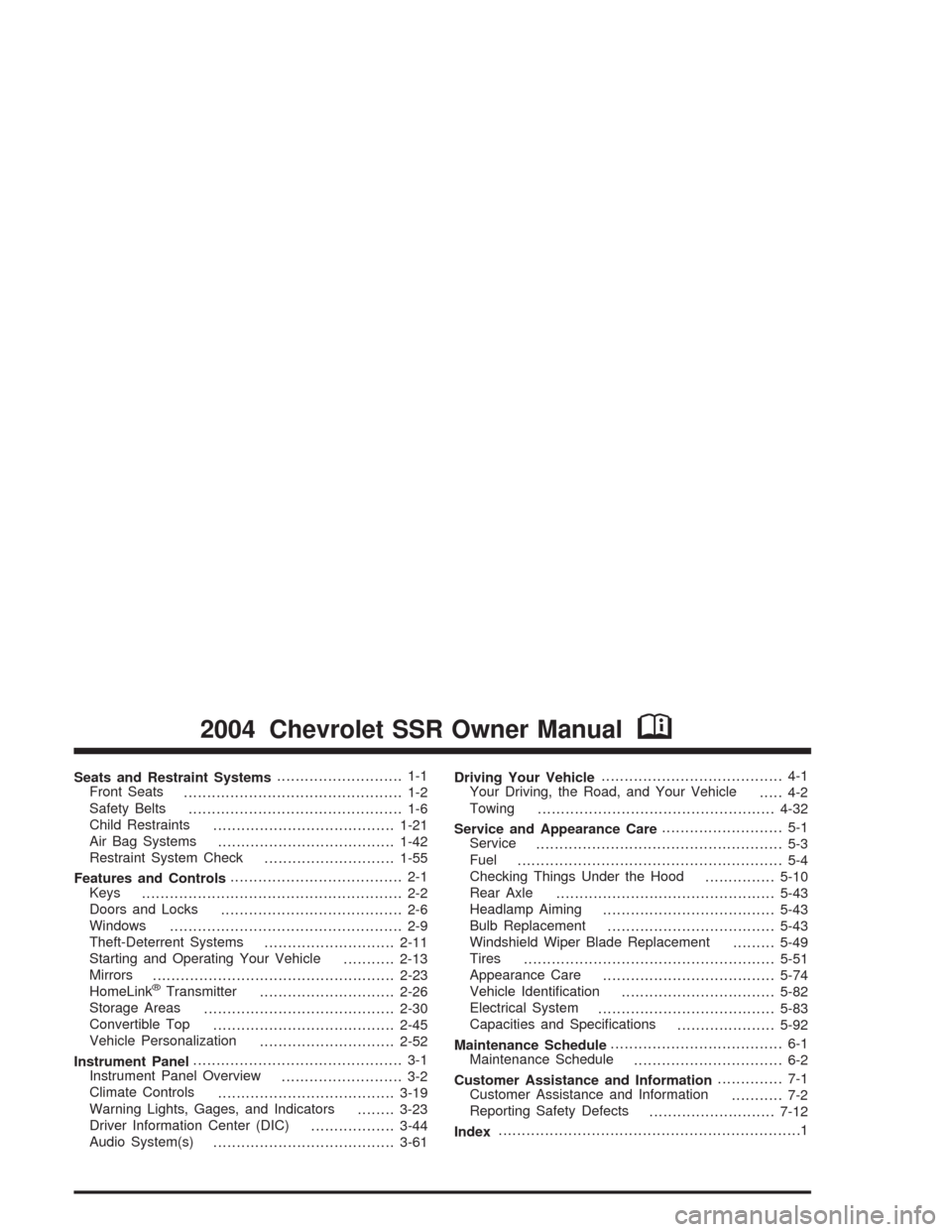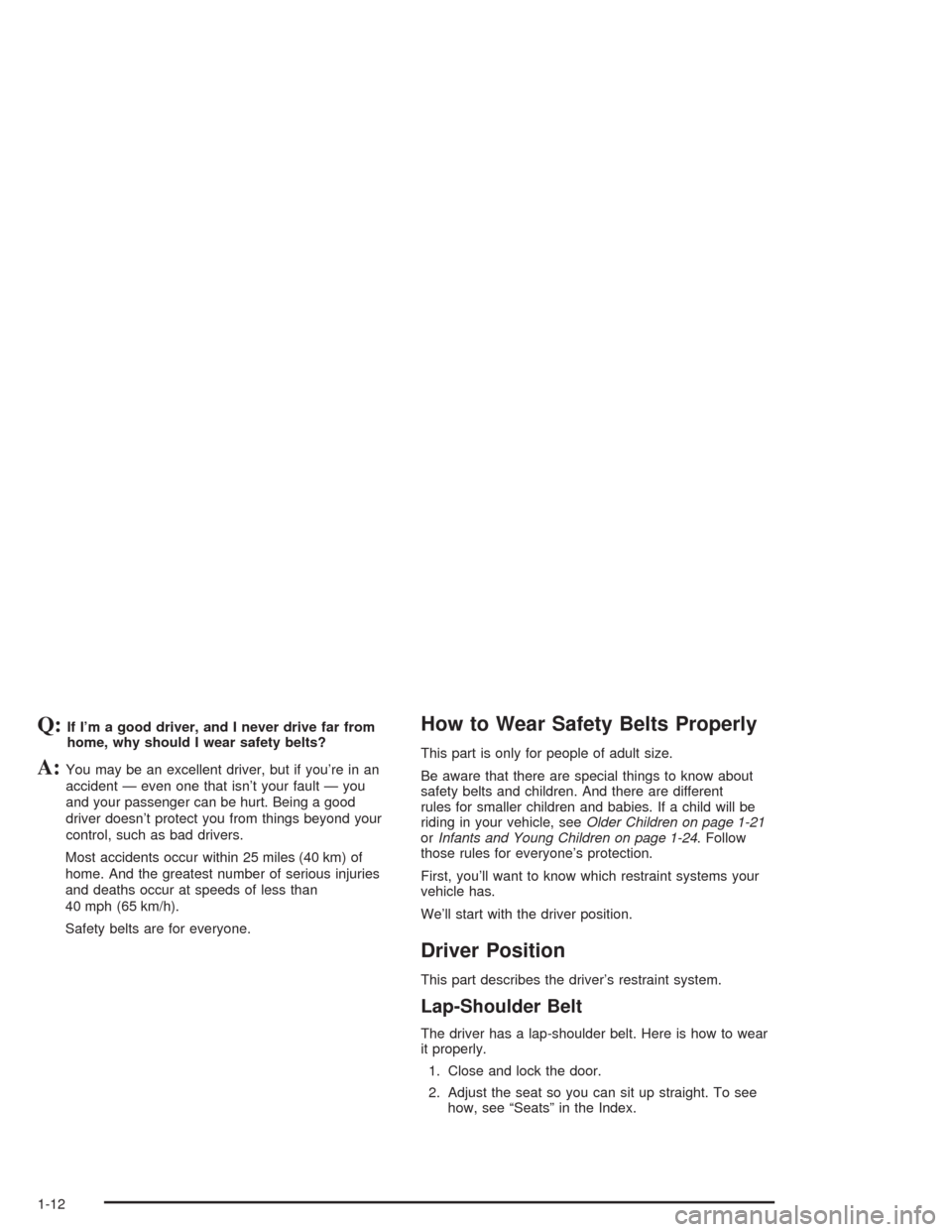Page 1 of 398

Seats and Restraint Systems........................... 1-1
Front Seats
............................................... 1-2
Safety Belts
.............................................. 1-6
Child Restraints
.......................................1-21
Air Bag Systems
......................................1-42
Restraint System Check
............................1-55
Features and Controls..................................... 2-1
Keys
........................................................ 2-2
Doors and Locks
....................................... 2-6
Windows
.................................................. 2-9
Theft-Deterrent Systems
............................2-11
Starting and Operating Your Vehicle
...........2-13
Mirrors
....................................................2-23
HomeLink
®Transmitter
.............................2-26
Storage Areas
.........................................2-30
Convertible Top
.......................................2-45
Vehicle Personalization
.............................2-52
Instrument Panel............................................. 3-1
Instrument Panel Overview
.......................... 3-2
Climate Controls
......................................3-19
Warning Lights, Gages, and Indicators
........3-23
Driver Information Center (DIC)
..................3-44
Audio System(s)
.......................................3-61Driving Your Vehicle....................................... 4-1
Your Driving, the Road, and Your Vehicle
..... 4-2
Towing
...................................................4-32
Service and Appearance Care.......................... 5-1
Service
..................................................... 5-3
Fuel
......................................................... 5-4
Checking Things Under the Hood
...............5-10
Rear Axle
...............................................5-43
Headlamp Aiming
.....................................5-43
Bulb Replacement
....................................5-43
Windshield Wiper Blade Replacement
.........5-49
Tires
......................................................5-51
Appearance Care
.....................................5-74
Vehicle Identi�cation
.................................5-82
Electrical System
......................................5-83
Capacities and Speci�cations
.....................5-92
Maintenance Schedule..................................... 6-1
Maintenance Schedule
................................ 6-2
Customer Assistance and Information.............. 7-1
Customer Assistance and Information
........... 7-2
Reporting Safety Defects
...........................7-12
Index.................................................................1
2004 Chevrolet SSR Owner ManualM
Page 10 of 398
This feature will heat the lower cushion and lower back
of the driver’s and passenger’s seats.
Press LO to turn the heater on low. Press HI to turn the
heater on high. Put the switch in the center position
to turn the heater off.
The ignition must be on for the heated seats to work.
Also, the passenger’s safety belt must be buckled for the
heated seat feature to work on the passenger’s seat.
If you turn the ignition off when the heated seats are on,
the heated seats will turn off. They will come on again
when you restart the vehicle.Reclining Seatbacks
To recline the seatback, lift the lever on the outboard
side of the seat cushion.
Release the lever to lock the seatback where you
want it. Pull up on the lever without pushing on the
seatback, and the seat will go to an upright position.
1-4
Page 12 of 398
Seatback Latches
The seatbacks fold forward.
To fold the seatback
forward, push the lever on
the side of the seatback
rearward and pull the
seatback forward.
To return the seatback to the upright position, push it all
the way back until the latch catches. If the seatback
was reclined before being folded forward, it will return to
the reclined position.{CAUTION:
If the seatback is not locked, it could move
forward in a sudden stop or crash. That could
cause injury to the person sitting there. Always
press rearward on the seatback to be sure it is
locked.
Safety Belts
Safety Belts: They Are for Everyone
This part of the manual tells you how to use safety
belts properly. It also tells you some things you should
not do with safety belts.
1-6
Page 18 of 398

Q:If I’m a good driver, and I never drive far from
home, why should I wear safety belts?
A:You may be an excellent driver, but if you’re in an
accident — even one that isn’t your fault — you
and your passenger can be hurt. Being a good
driver doesn’t protect you from things beyond your
control, such as bad drivers.
Most accidents occur within 25 miles (40 km) of
home. And the greatest number of serious injuries
and deaths occur at speeds of less than
40 mph (65 km/h).
Safety belts are for everyone.
How to Wear Safety Belts Properly
This part is only for people of adult size.
Be aware that there are special things to know about
safety belts and children. And there are different
rules for smaller children and babies. If a child will be
riding in your vehicle, seeOlder Children on page 1-21
orInfants and Young Children on page 1-24. Follow
those rules for everyone’s protection.
First, you’ll want to know which restraint systems your
vehicle has.
We’ll start with the driver position.
Driver Position
This part describes the driver’s restraint system.
Lap-Shoulder Belt
The driver has a lap-shoulder belt. Here is how to wear
it properly.
1. Close and lock the door.
2. Adjust the seat so you can sit up straight. To see
how, see “Seats” in the Index.
1-12
Page 20 of 398
The lap part of the belt should be worn low and snug on
the hips, just touching the thighs. In a crash, this
applies force to the strong pelvic bones. And you would
be less likely to slide under the lap belt. If you slid
under it, the belt would apply force at your abdomen.
This could cause serious or even fatal injuries. The
shoulder belt should go over the shoulder and across
the chest. These parts of the body are best able to take
belt restraining forces.
The safety belt locks if there is a sudden stop or crash,
or if you pull the belt very quickly out of the retractor.
1-14
Page 26 of 398

The best way to protect the fetus is to protect the
mother. When a safety belt is worn properly, it’s more
likely that the fetus won’t be hurt in a crash. For
pregnant women, as for anyone, the key to making
safety belts effective is wearing them properly.
Passenger Position
To learn how to wear the passenger’s safety belt
properly, seeDriver Position on page 1-12.
The passenger’s safety belt works the same way as the
driver’s safety belt — except for one thing. If you
ever pull the shoulder portion of the belt out all the way,
you will engage the child restraint locking feature. If
this happens, just let the belt go back all the way and
start again.
Safety Belt Extender
If the vehicle’s safety belt will fasten around you, you
should use it.
But if a safety belt isn’t long enough to fasten, your
dealer will order you an extender. It’s free. When you go
in to order it, take the heaviest coat you will wear, so
the extender will be long enough for you. The extender
will be just for you, and just for the seat in your
vehicle that you choose. Don’t let someone else use it,
and use it only for the seat it is made to �t. To wear
it, just attach it to the regular safety belt.
1-20
Page 46 of 398
4. Buckle the belt. Make sure the release button is
positioned so you would be able to unbuckle the
safety belt quickly if you ever had to.5. Pull the rest of the shoulder belt all the way out of
the retractor to set the lock.
1-40
Page 53 of 398

{CAUTION:
If something is between an occupant and an
air bag, the bag might not in�ate properly or it
might force the object into that person causing
severe injury or even death. The path of an
in�ating air bag must be kept clear. Do not put
anything between an occupant and an air bag,
and do not attach or put anything on the
steering wheel hub or on or near any other air
bag covering. Do not let seat covers block the
in�ation path of a side impact air bag.
When Should an Air Bag In�ate?
The driver’s and passenger’s frontal air bags are
designed to in�ate in moderate to severe frontal or
near-frontal crashes. But they are designed to in�ate
only if the impact speed is above the system’s designed
“threshold level.”
In addition, your vehicle has “dual stage” frontal air bags,
which adjust the amount of restraint according to crash
severity. For moderate frontal impacts, these air bags
in�ate at a level less than full deployment. For more
severe frontal impacts, full deployment occurs. If the front
of your vehicle goes straight into a wall that does not
move or deform, the threshold level for the reduced
deployment is about 12 to 16 mph (19 to 26 km/h), and
the threshold level for a full deployment is about 20 to
25 mph (32 to 40 km/h). The threshold level can vary,
however, with speci�c vehicle design, so that it can be
somewhat above or below this range.
If your vehicle strikes something that will move or
deform, such as a parked car, the threshold level will be
higher. The driver’s and passenger’s frontal air bags
are not designed to in�ate in rollovers, rear impacts, or
in many side impacts because in�ation would not
help the occupant.
1-47